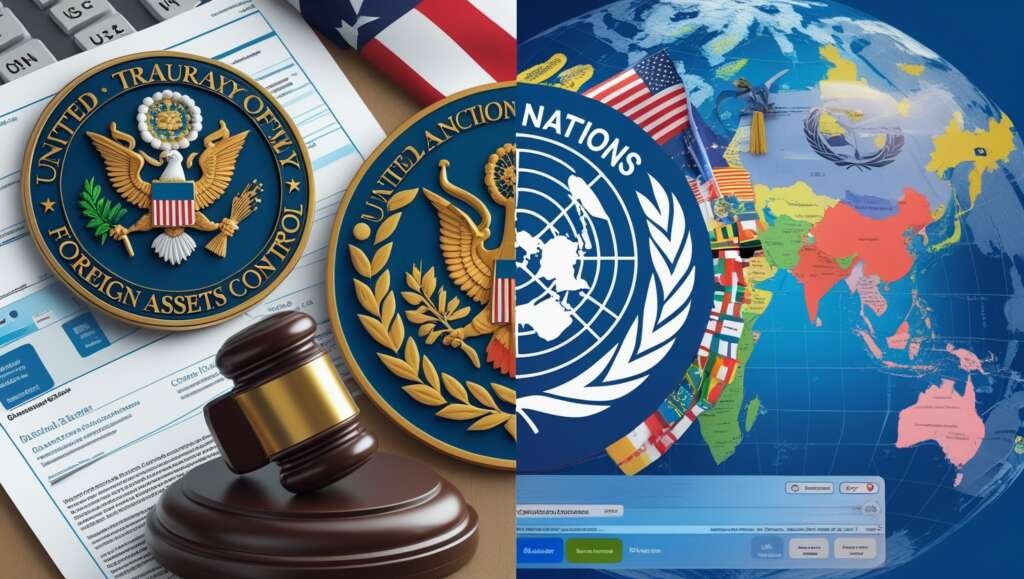If you’re working in compliance, banking, crypto, trade, or even diplomacy, you’ll eventually come across something called “sanctions.” And two names often pop up: OFAC and the United Nations (UN). Now, while both issue sanctions, they’re not created equal — they serve different purposes, follow different rules, and, most importantly, are enforced in very different ways.
Let’s take a walk through history, unpack how both systems work, and finally zero in on the core difference: OFAC sanctions typically require asset blocking, while UN sanctions may not.
Historical Background
The Birth of Sanctions as a Diplomatic Tool
Sanctions have been used throughout history — even ancient Athens used trade restrictions in the 5th century BCE. But as a formal global policy tool, economic sanctions became a recognized statecraft method in the 20th century, especially after the two World Wars.
The League of Nations, founded after World War I, experimented with sanctions to discourage aggression. But it was after World War II, with the creation of the United Nations, that sanctions really became part of a multilateral framework designed to maintain international peace and security.
The Emergence of the United Nations Sanctions Framework
The United Nations Security Council (UNSC) was established in 1945, and it was given the authority under Chapter VII of the UN Charter to impose sanctions. These sanctions are binding on all 193 UN member states. Over the decades, UN sanctions have been used in situations involving terrorism, nuclear proliferation, civil wars, and human rights abuses — for instance, in North Korea, Iran, Libya, and South Sudan.
UN sanctions were originally broad and applied at a country level. But over time — especially after criticisms in the 1990s (like the humanitarian impact of sanctions on Iraq) — the UN refined its tools, moving toward “smart sanctions” or targeted sanctions. These focus more on individuals, entities, or sectors rather than entire populations.
OFAC: The United States’ Sanctions Powerhouse
On the other side of the Atlantic, the United States has its own approach. After WWII, and especially during the Cold War, the U.S. began to leverage its economic dominance to apply unilateral sanctions — that is, sanctions imposed without needing international agreement.
To manage these sanctions, the U.S. Treasury Department created the Office of Foreign Assets Control (OFAC) in 1950, originally in response to the Korean War. Over time, OFAC evolved into a key agency in enforcing U.S. foreign policy and national security interests, using the American financial system as its enforcement weapon.
So, the UN takes a global, diplomatic approach, while OFAC represents a U.S.-centric enforcement-driven approach.
The Legal Foundations: Who Has the Power to Sanction?
-
UN Sanctions
The legal authority for UN sanctions comes from the UN Charter, specifically Article 41 of Chapter VII, which allows the Security Council to decide on “measures not involving the use of armed force.” This includes:
- Trade restrictions
- Arms embargoes
- Travel bans
- Financial and asset freezes
Once passed, these measures are binding under international law for all UN members.
However, here’s the key: enforcement is left to individual countries. The UN does not have a direct enforcement arm. Instead, each country must pass domestic laws or regulations to implement the sanctions.
-
OFAC Sanctions
OFAC derives its authority primarily from U.S. laws such as:
- The Trading with the Enemy Act (1917)
- The International Emergency Economic Powers Act (IEEPA)
- Various executive orders by the President
When OFAC issues a sanction, it has immediate legal force in the United States. It can:
- Freeze (block) assets
- Prohibit transactions
- Penalize U.S. persons and businesses (and even foreign entities doing business with sanctioned targets)
OFAC sanctions are domestic U.S. laws — but their global impact is massive because of the dominance of the U.S. dollar and U.S. financial institutions.
The Practical Difference: Blocking Assets
Let’s get to the heart of the matter.
OFAC sanctions require asset blocking; UN sanctions may not.
This is the key operational difference between the two.
What is Asset Blocking?
Asset blocking means freezing any property or financial assets of a sanctioned party — whether an individual, entity, or government — that falls under U.S. jurisdiction. Once blocked:
- The assets cannot be transferred, withdrawn, exported, or dealt with in any way.
- U.S. persons (citizens, companies, financial institutions) are prohibited from engaging in any transactions with the sanctioned party.
OFAC maintains a famous list called the SDN List — the Specially Designated Nationals and Blocked Persons List — which contains the names of individuals and companies whose assets are blocked and with whom U.S. persons are generally prohibited from dealing.
How Does the UN Handle Assets?
UN sanctions may include asset freezes — but they don’t always require them. And when they do, it is up to each UN member country to implement those freezes via their own legal and financial systems.
For example, if the UN imposes a travel ban and asset freeze on certain political leaders in a conflict zone, it’s up to countries like the UK, France, South Africa, or Japan to ensure that their own banks freeze the relevant accounts.
The key difference here is that UN sanctions are not self-executing. They need to be translated into domestic law to be enforceable. And this sometimes leads to uneven application, delays, or even non-enforcement in certain jurisdictions.
Global Reach and Compliance Pressure
Why Are OFAC Sanctions So Widely Followed — Even Outside the U.S.?
Two words: Dollar Dominance.
Because most global trade and finance is conducted in U.S. dollars, and because most international transactions clear through U.S. banks, even non-U.S. entities tend to comply with OFAC sanctions to avoid getting cut off from the dollar-based financial system.
For example:
- A bank in Germany or Dubai might freeze an account not because their government required it, but because the client appears on the OFAC SDN list.
- A cryptocurrency exchange in Asia may block a user flagged by OFAC even if their own country hasn’t sanctioned that person.
Why? Because violating OFAC can lead to:
- Hefty fines (sometimes in billions of dollars)
- Getting “de-risked” by U.S. banks (cutting off all correspondent relationships)
- Criminal prosecution
UN Sanctions: Multilateral but Less Aggressive
UN sanctions, while more universally legitimate, lack the teeth that OFAC sanctions have in practice. The UN relies on political consensus. That makes them less nimble and harder to enforce.
Moreover, enforcement depends on the political will and capacity of each country. Some nations might lack the resources to track financial flows, while others may deliberately ignore UN resolutions for political reasons.
Examples to Illustrate the Difference
Example 1: North Korea
- The UN has imposed multiple rounds of sanctions on North Korea for its nuclear weapons program.
- These include arms embargoes, bans on luxury goods, and asset freezes.
At the same time, the U.S. has imposed unilateral OFAC sanctions — designating North Korean individuals, shipping companies, and even Chinese firms believed to support the regime.
If you’re a U.S. person (or foreign company using the U.S. banking system), you are required to block any property of sanctioned North Korean entities. But a country like Russia or Iran — though UN members — may choose not to enforce UN sanctions.
Example 2: Iran Nuclear Deal
In 2015, after the Iran nuclear deal (JCPOA), the UN lifted some of its sanctions.
The U.S., however, maintained many OFAC sanctions — especially on non-nuclear issues (e.g., human rights abuses, terrorism). This created confusion: European companies wanted to trade with Iran (since UN and EU sanctions had been lifted), but many backed out of Iranian deals for fear of U.S. secondary sanctions.
This example shows how OFAC sanctions have global impact, even when the UN does not impose the same restrictions.
Key Takeaways: Comparing UN vs. OFAC Sanctions
| Feature | UN Sanctions | OFAC Sanctions |
| Imposed by | United Nations Security Council | U.S. Treasury (via Executive Orders & federal law) |
| Scope | Multilateral (all UN member states) | Unilateral (U.S. jurisdiction, but with global reach) |
| Binding? | Yes, under international law | Yes, under U.S. law |
| Enforcement | Must be implemented by member states | Direct and immediate under U.S. law |
| Asset Blocking | Optional (depends on resolution) | Mandatory if listed by OFAC |
| List of Targets | Designated by UN resolutions | Listed on OFAC SDN and other lists |
| Effectiveness | Depends on political will and capacity of member states | Very effective due to U.S. financial leverage |
Why the Difference Matters
Understanding the difference between OFAC and UN sanctions is critical for global compliance teams, financial institutions, lawyers, and businesses operating across borders.
At the core of this difference is how sanctions are enforced.
- OFAC sanctions bite hard — they block assets, restrict access to the U.S. financial system, and penalize violators globally.
- UN sanctions rely on cooperation — their strength lies in legitimacy, not in enforcement.




